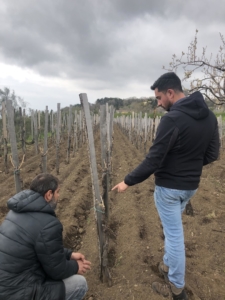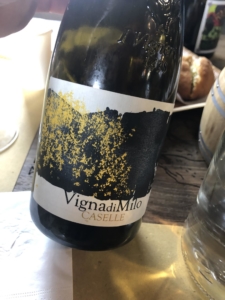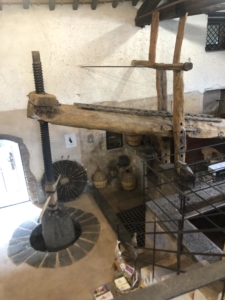
Simone Foti and vignaiolo Gianni Lonetti (crouching), from Cirò, Calabria admire the I Vigneri pruning methods.
In September of 2022, I headed to Mt. Etna for a master-class tasting of wines from Versante Est (East Face). The eastern side of Mt. Etna is dominated by the Etna Bianco Superiore designation as the Milo commune is the only area that can produce the Superiore version. The Superiore in this case does indeed give the wine a bit of “superior” status. Milo is historically known for its white wines–red grapes have difficulty growing in this part of the region, and the soil composition is different from the rest of Etna.
At the time of this tasting, I already had an Etna harvest and multiple visits under my belt, thinking myself an expert and knowing who made the best of the best on the Volcano. This particular experience at the master class, however, turned my preconceptions inside out, a testament to the dynamism and the ever-changing landscape of Mt. Etna.
Etna is full of big names, one such being Salvo Foti and his I Vigneri project. I have always been a fan of Salvo and his philosophies: his insistence of the alberello vine-training system (a free vine-training system with a high planting density, a tradition from the ancient Greek colonies); minimal intervention in the cellar (no chemicals or additions, minimal use of sulfur, and no filtration); and later, his focus on native grape varieties. When I Vigneri first came onto the American market, they were some of the first Italian wines to enter the “natural wine” discourse.
I Vigneri takes its name from an association that existed in the region in 1435: Maestranzi dei Vigneri, an association of vineyard workers in eastern Sicily. Today, I Vigneri is a collaboration between Salvo Foti, local vine experts, and grape growers. The Vigneri do all the work that needs to be done in the vineyards throughout the year: plant, prune, graft, and repair the dry lava stone terraces. The group’s primary goal, of course, is the organization and preservation of Mt. Etna’s and eastern Sicily’s wine heritage.
*****
For me personally, Foti’s wines changed my career trajectory. From the moment I tasted them and learned about his work, I shifted my focus to the promotion and sale of wines made by vignaioli who work organically (and beyond) in the vineyard, practice minimal intervention in the cellar, and who invest in their local communities.
Yet, along the way, something happened; I can’t quite tell you what exactly, but I lost interest in the wines. Certainly not the work behind them, as I discovered other winemaking projects involving Foti’s I Vigneri that I enjoyed tremendously. Was it the worldwide explosion of Mt. Etna and Sicilian wines on the market that pulled my attention away from the wines? Or did the wines really lose their once distinct character?
the wines really lose their once distinct character?
So, when I Vigneri presented the 2020 Vigna di Milo Etna Bianco Superiore back in September, I didn’t have high expectations–but after my first sip, I cocked my head, squinted my eyes, and immediately turned to my left and my right–I wanted to catch the faces of my friends, both winemakers on Etna. They both had the same reaction; the wine had surprised them too.
There was a finesse we had never noticed in them before. The acidity was bright, the quintessential but subtle petrol note from an aged carricante was present, and the salinity of the Milo cru was unmistakable. It was truly everything I look for in a wine: true to the flavor profile of the grape, expressive of its terroir, and yet still unique with a hallmark of the producer. This was not the wine of I Vigneri past. What changed?
*****
A few weeks ago, I embarked on yet another trip to Etna (I just can’t stay away). After my revelatory experience at the September tasting, I wanted to visit the I Vigneri estate to meet the new enologists, Simone and Andrea Foti. Simone and Andrea naturally followed in their father’s footsteps and have taken over production at the winery. “Our dad never forced us to work in the family business,” Simone says. “He always encouraged us to follow our own interests.” Simone attended the prestigious wine school of Beaune, in Burgundy, and continued his viticulture experience in Burgundy, Loire, Champagne, and Jura.

The converted palmento (traditional winemaking structure) is now the I Vigneri tasting room, complete with a stomping (pressing) area, fermentation vats carved out of volcanic rock, and a large, corkscrew-like press.
Andrea, the younger of the two, attended the State University of Milan, graduating in viticulture and oenology. While both are certified enologists, Simone’s joy and expertise lie in the vineyards, and Andrea’s in the cantina (winery), making them the perfect duo for the job.
With the Fratelli Foti at the helm of I Vigneri, the wines are finding new life. They have upheld the ethos and maintained the practices of their father, but also bring in their own personal experience and taste. Their wines are multifaceted and layered, and I am certainly not the only one who has noticed this advancement in quality and character as the higher-end cru and old-vine bottlings become more strictly allocated.
At Paul Marcus Wines, we’re fortunate to have recently received a shipment of three Foti wines: the 2020 Vigna del Milo Etna Bianco Superiore, the 2021 Etna Rosso, and the 2021 Aurora Etna Bianco. To learn more about these stellar bottlings, come visit us at the shop. I’m always happy to chat about i Foti and their fascinating wine.
— Emilia Aiello
